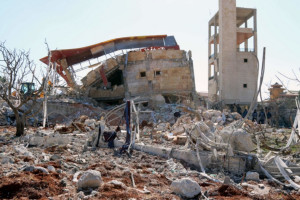The Safety of Hospitals and Civilian Targets

On 28 February, an accord lead by the United States and Russia started the first day of a “cessation of hostilities” in Syria. The accord was accepted by President Bashar al-Assad’s government and many of his opponents, giving some analysts in the United Nations hope that the accord can pave meaningful diplomatic ground between the parties. The ceasefire can also give aid groups time to reach civilians in war-torn areas, helping mitigate the rising number of casualties in a war that has currently killed more than 250,000 people and left eleven million homeless.
Critically, the truce does not cover all parties within the conflict. Certain jihadist groups were not signed onto the treaty, such as the Islamic State and the Nusra Front, al Qaeda’s branch in Syria. Some members of these groups continue to be hostile towards opposing parties and civilians, though others have retreated from residential areas. Given the presence of these jihadist groups, Moscow and Damascus continue to launch military strikes against supposed terrorist groups. These attacks were included in the truce despite concerns from signatories that these exemptions may justify attacks against rebel fighters.
These exemptions were condemned by international aid groups, many of which are using this ceasefire to give much-needed supplies and medical support to at-risk areas. For example, Widney Brown, the director of programs at Physicians for Human Rights, criticized the lack of provisions that address the bombing of civilian facilities. Hospitals and local health centers were often targeted by both Syrian fighters and terrorist groups before the accord, and there are fears that they will remain prominent targets.
These concerns over the targeting of civilian facilities has renewed discussions between international aid groups over ethical military conduct both in Syria and abroad. According to studies by Physicians for Human Rights between March 2011 and December 2015, there were 346 attacks on 246 medical facilities across Syria, resulting in 746 killed medical personnel. Doctors Without Borders has confirmed some of these numbers. Internal data from 2015 show ninety-four attacks on sixty-seven the hospitals and clinics that were run by the group, resulting in the destruction of twelve facilities and the deaths of twenty-three staff members.
Notably, the opposing forces have resorted to other tactics alongside aerial strikes. According to Amnesty International, al-Assad’s army has detained health workers, arrested hospital patients, and prevented physicians from treating protestors since the hostilities in 2011. These acts occurred even within humanitarian health centers that have taken no side in the conflict.
Some groups claim that these events show the intentional targeting of civilian and humanitarian targets within the Syrian civil war. Others take this claim further, emphasizing that this military strategy is becoming standard practice globally despite being forbidden under international law. They point to the aerial bombing of a hospital run by Doctors Without Borders in Afghanistan in October last year, which killed fourteen medical staff and twenty-four patients. The event shocked social media and generated scorn from different international communities, but little has occurred to stop these hostilities.
When Russian and Syrian forces were criticized for a number of hospital bombings, such as those on a Doctors Without Borders hospital on 9 February in southern Syria, their military officials were quick to deflect the accusation. They claimed that their air force neither targeted these facilities nor intentionally killed civilians, directing blame instead on opposing rebel forces as the cause of these attacks. During other attacks, they justified their actions by claiming the presence of terrorists within the area. While US forces have criticized Russia and Syria for their conduct, their own military personnel used similar justifications in their attacks. The initial report on the hospital bombing in Afghanistan, for example, claimed that insurgent fighters took cover in the compound.
As the military forces in Syria settle into the ceasefire, only time will tell if the peace will actually last. Military personnel from both sides reported a cautious optimism during the first few days of the accord, noting that their battlefields were uncharacteristically quiet. And while humanitarian workers are certainly taking advantage of this moment to recoup, many are still on guard for any potential attacks in their area, knowing that they are practically outside the bounds of the agreement.
